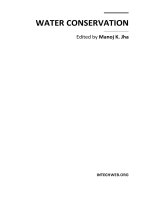GIS Methodologies for Developing Conservation Strategies Part 1 docx
Bạn đang xem bản rút gọn của tài liệu. Xem và tải ngay bản đầy đủ của tài liệu tại đây (1.17 MB, 27 trang )
GIS Methodologies
for Developing
Conservation Strategies:
TROPICAL FOREST
RECOVERY AND
WILDLIFE
MANAGEMENT IN
COSTA RICA
Basil G. Savitsky and
Thomas E. Lacher
COLUMBIA UNIVERSITY PRESS
GIS Methodologies
for Developing
Conservation Strategies
Biology and Resource Management Series
Michael J. Balick, Anthony B. Anderson, and Kent H. Redford, Editors
Biology and Resource Management Series
Edited by Michael J. Balick, Anthony B. Anderson, and Kent H. Redford
Alternatives to Deforestation: Steps Toward Sustainable Use of the Amazon Rain
Forest,
edited by Anthony B. Anderson
Useful Palms of the World: A Synoptic Bibliography,
compiled and edited by Michael J. Balick and Hans T. Beck
The Subsidy from Nature: Palm Forests, Peasantry, and Development on an Amazon
Frontier,
by Anthony B. Anderson, Peter H. May, and Michael J. Balick
Contested Frontiers in Amazonia,
by Marianne Schmink and Charles H. Wood
Conservation of Neotropical Forests: Working from Traditional Resource Use,
edited by Kent H. Redford and Christine Padoch
The African Leopard: Ecology and Behavior of a Solitary Felid,
by Theodore N. Bailey
Footprints of the Forest: Ka’apor Ethnobotany—the Historical Ecology of Plant
Utilization by an Amazonian People,
´
by William Balee
Medicinal Resources of the Tropical Forest: Biodiversity and Its Importance to Human
Health,
edited by Michael J. Balick, Elaine Elisabetsky, and Sarah A. Laird
The Catfish Connection: Ecology, Migration, and Conservation of Amazon Predators,
Ronaldo Barthem and Michael Goulding
So Fruitful a Fish: Ecology, Conservation, and Aquaculture of the Amazon’s Tambaqui,
Carlos Araujo-Lima and Michael Goulding
GIS Methodologies
for Developing
Conservation Strategies
Tropical Forest Recovery and
Wildlife Management
in Costa Rica
Basil G. Savitsky and Thomas E. Lacher Jr., Editors
Columbia University Press
New York
Columbia University Press
Publishers Since 1893
New York
Chichester, West Sussex
Copyright ᭧ 1998 by Columbia University Press
All rights reserved
Library of Congress Cataloging-in-Publication Data
GIS methodologies for developing conservation strategies : tropical
forest recovery and wildlife management in Costa Rica / Basil G.
Savitsky and Thomas E. Lacher Jr., editors.
p.
cm. — (Biology and resource management
series)
Includes bibliographical references and index.
ISBN 0–231–10026–4 (cloth : alk. paper)
1. Wildlife conservation—Costa Rica—Remote sensing. 2. Forest
conservation—Costa Rica—Remote sensing. 3. Geographic information
systems—Costa Rica. 4. Digital mapping.
I. Savitsky, Basil G.
II. Lacher Jr., Thomas E.
III. Series.
QH77.C8G57
1998
333.95Ј 16Ј097286—dc21
97–38069
Casebound editions of Columbia University Press
books are printed on permanent and durable acid-free paper.
Printed in the United States of America
c 10 9 8 7 6 5 4 3 2 1
For
Ava, Lily, and Isabella
and
´
Iara and Laıs
This page intentionally left blank
Contents
Foreword by James D. Nations
xi
Preface
xiii
Abbreviations
xvii
PART O NE: Overview
1. The Spatial Nature of Conservation and Development
Thomas E. Lacher Jr.
2. Conservation Mapping in Costa Rica
Christopher Vaughan, Jorge Fallas, and Michael McCoy
PART T WO: Digital Mapping Technologies
1
3
13
27
3. Digital Mapping Technologies
Basil G. Savitsky
29
4. GIS
Basil G. Savitsky
41
5. Image Analysis
Basil G. Savitsky
48
6. GPS
Jeffery S. Allen
61
viii
Contents
PART T HREE: Uses of GIS—Examples in Costa Rica
81
7. GIS Design and Implementation at La Selva Biological Station
Elizabeth A. Wentz and Joseph A. Bishop
83
8. Use of Digital Elevation Models in Tropical Rain Forest Basins
to Extract Basic Hydrologic and Land Use Information
´
G. Arturo Sanchez-Azofeifa
96
9. Using a GIS to Determine Critical Areas in the Central Volcanic
Cordillera Conservation Area
´
´
Gregoire Leclerc and Johnny Rodriguez Chacon
108
10. Application of the HEP Methodology and Use of GIS to Identify Priority Sites for the Management of White-Tailed Deer
´
Wilfredo Segura Lopez
127
11. The Paseo Pantera Project: A Case Study Using GIS to Improve
Continental-Scale Conservation Planning
J. David Lambert and Margaret H. Carr
138
PART F OUR: The USAID Case Study in Gap Analysis
149
12. Overview of Gap Analysis
Basil G. Savitsky
151
13. Wildlife and Habitat Data Collection and Analysis
Basil G. Savitsky, Jorge Fallas, Christopher Vaughan, and
Thomas E. Lacher Jr.
158
14. Error and the Gap Analysis Model
Jennifer N. Morgan and Basil G. Savitsky
170
15. A GIS Method for Conservation Decision Making
Basil G. Savitsky and Thomas E. Lacher Jr.
179
16. Using the Gap Analysis Model for Sustainable Development
and Natural Resources Management in Developing Countries
Thomas E. Lacher Jr.
199
17. Application of the Gap Analysis Model in Regional and International Programs in the Tropics
Thomas E. Lacher Jr., G. Wesley Burnett, Basil G. Savitsky, and
Christopher Vaughan
210
Appendix 1
219
Appendix 2
223
Contents
ix
Appendix 3
225
Appendix 4
231
Appendix 5
233
Contributors
237
Index
239
This page intentionally left blank
Foreword
James D. Nations
We shall not cease from exploration
And the end of all our exploring
Will be to arrive where we started
And know the place for the first time.
— T. S. Eliot, “Little Gidding” (1942)
Every sixteen days a Landsat satellite passes silently over the tropical landscape
of Costa Rica, recording digital data on the rain forests, savannas, rivers, lakes,
and mountains that lie 918 kilometers below. The recorded data are a worthless
collection of zeros and ones until the scientific mind manipulates them and
transforms them into images that have meaning for the future of human beings
and the thousands of species that live in the habitats the images depict.
The analysis of remotely sensed images has come a long way from the biplane
flights of World War I pilots, who brought back film that inadvertently showed
traces of Roman-era ruins in British wheat fields. Seen from the air, the small
rises and dips that farmers stepped across could be recognized as the foundations
and walls of centuries-old Roman buildings. In the tropics today we find it easier
to locate the ruins of ancient civilizations from hundreds of kilometers in space
than from a hundred meters through the dense, green screen of the rain forest
itself.
Combined with the seeming wizardry of digital mapping technologies, the
applications of remote sensing have become enormous: mapping indigenous
territories to monitor illegal encroachment, tracing national park boundaries
across international boundaries and through unmarked wilderness, identifying
wildlife habitat in regions where humans have no easy access, and so forth. The
applications of digital images and digital mapping take us out of the realm of
guesswork and into the world of the technological future. We are limited ony by
our own creativity.
In this volume editors Basil G. Savitsky and Thomas E. Lacher Jr. bring us
new and novel applications for this future, including a gap analysis technique
xii
Foreword
that allows researchers to superimpose the distribution of wildlife species on the
boundaries of protected areas. This technique can show us where new work
should be focused—where conservation is working and where it is not. In a series
of case studies from Costa Rica, the authors point us toward new applications of
digital mapping for the conservation of natural habitats and our work toward
sustainable development.
These techniques and the visual images they create are becoming powerful
tools in the hands of development specialists, financial decision-makers, and
political leaders. We can no longer claim that we do not have the information we
need to make sound decisions about the natural environment. The tools are ours,
the data are real, and the future is literally in our hands.
James D. Nations, Ph.D.
Conservation International
Washington, D.C.
Preface
This book, and the research it is based upon, is the result of what makes
most science happen today. An idea circulated among a network of individual
acquaintances caught fire and stimulated the development of a proposal that was
ultimately funded, leading to an outcome much larger and far-reaching than any
one participant could have expected or produced. The seed was planted when
then Ph.D. candidate Savitsky walked into the office of Clemson University
faculty member (and director of the Archbold Tropical Research Center) Lacher
and suggested doing a dissertation research project that would combine his
interest in geographic information systems (GIS) and Central America. At the
time, Lacher had worked mostly in the Caribbean and Brazil but knew Christopher Vaughan of the Universidad Nacional (UNA) from several conferences and
workshops. We contacted Chris, who put us in touch with Jorge Fallas, and thus
began the discussions of research ideas that, over time, developed into our
research proposal and eventually this book.
The first concrete discussions occurred when Savitsky went to Costa Rica and
met with the faculty and staff at UNA. The idea of a modified gap analysis began
to develop about this time; the challenge was to develop an approach that had
been applied with success in the United States but had yet to be utilized in a
more data-poor country. The original idea was to do a regional project that would
contrast countries with different levels of data availability, but this was soon
discounted owing to logistical difficulties. We developed a proposal for Costa
Rica together with our colleagues at UNA and were funded by the United
States Agency for International Development (USAID) in a competitive grants
competition.
xiv
Preface
Once we decided to focus on Costa Rica, we began to refine the approach.
During a subsequent visit to Costa Rica by Savitsky, Lacher, and Wesley Burnett,
we developed the idea of a three-sided decision matrix that would provide for
multiple alternative management strategies for any given gap analysis. This
seemed a particularly fruitful approach for developing countries with less data
on wildlife distributions.
As we began to collect data for the project and to discuss our preliminary
findings with colleagues, we were pleased with both the interest expressed and
the suggestions we began to receive. One colleague, Kent Redford of the Nature
Conservancy, suggested we contact Columbia University Press since our research
seemed to be appropriate for several new series of books on the tropics that CUP
had begun. We submitted a proposal to Ed Lugenbeel, which was accepted, and
we have received excellent support from him, Alissa Bader, and Roy Thomas
throughout the development of the manuscript.
A substantial proportion of the material in this volume is derived from
Savitsky’s Ph.D. dissertation, but much additional information has been added
to round out and expand it. Chapter 14 (“Error and the Gap Analysis Model”) is
the result of an undergraduate honors research project by Clemson University
student Jennifer Morgan. Chapter 6 (“GPS”) was developed by Jeffery Allen to
incorporate his experience in GPS training in Costa Rica. Christopher Vaughan,
Jorge Fallas, and Michael McCoy have contributed their knowledge of Costa Rica
to provide sufficient background for the reader. Finally, the section of five papers
on the use of GIS in Costa Rica has been included to show the diversity of
approaches and applications of GIS in the tropics.
The book is divided into four distinctly different parts. Part one provides an
overview of the spatial nature of conservation and management activities and
the current status of conservation mapping in Costa Rica. Part two offers a
review of the basic principles behind GIS, the Global Positioning System (GPS),
and image analysis. This section places a special emphasis on the application of
these technologies in developing tropical countries. Part three presents a set of
five research projects from Costa Rica that used digital mapping technologies at
a variety of scales and for a variety of conservation and management purposes.
The scales vary from local (La Selva Biological Station) to regional (the Paseo
Pantera project), and activities include single-species management plans, ecosystem conservation, and the management of watersheds. The final section, part
four, presents the results of the Costa Rican gap analysis project. The layout of
the book will allow even readers with no previous exposure to digital mapping
technologies to gain a sufficient understanding of the techniques to be able to
follow the research results.
We have many people we wish to acknowledge. It is impossible to conduct
international research without colleagues in-country, and in our case we were
fortunate to have the strong support of professors Jorge Fallas and Christopher
Preface
xv
Vaughan at the Programa Regional en Manejo de Vida Silvestre para Mesoamerica y el Caribe (PRMVS), Universidad Nacional, Heredia. We wish to thank the
´
´
staff of Professor Fallas’s Laboratorio de Teledeteccion y Sistemas de Informacion
´
Geografica in Costa Rica for their assistance throughout the project, and other
staff of the PRMVS which assisted with various aspects of the research.
We acknowledge the work of David Tarbox on this project; he could well be
listed as an author for his work on data entry and analysis and for the production
of many of the maps. We also thank Craig Campbell and Jeannine Maldonado
for data entry and Donald Van Blaricom for technical guidance in ARC/INFO.
Dr. Hoke Hill provided valuable advice concerning statistics, and Robert Sandev
was instrumental in creating several of the figures.
We thank all the staff of the Strom Thurmond Institute and the Archbold
Tropical Research Center who contributed to this project while both of us were at
Clemson University. In addition to writing a chapter for the book, Jeffery Allen
provided encouragement and support throughout the project. Patrick Harris
helped with data transfers and provided software support. Jean Martin provided
secretarial support and helped with presentation materials, and Diane Moore
and Janice Rogers kept track of finances and purchasing. Martha Morris and
Kathy Skinner assisted with word processing on earlier drafts.
Basil Savitsky especially thanks Dr. Robert H. Becker for his mentorship
while completing his Ph.D., for backing all of his work, and for cochairing his
doctoral committee; his coeditor and cochair (Thomas E. Lacher Jr.) and the rest
of his committee (Dr. G. Wesley Burnett, Dr. Kerry R. Brooks, and Dr. James B.
London) for their support and guidance; and Jackie, Ava, and Lily Savitsky for
their help in the preparation of his dissertation, much of which came to be
included in his chapters in this volume.
This research was supported under Grant No. HRN-5600-G-002008-00, Program in Science and Technology Cooperation, Office of the Science Advisor,
United States Agency for International Development.
Basil G. Savitsky
Worcester, Massachusetts
Thomas E. Lacher Jr.
College Station, Texas
This page intentionally left blank
Abbreviations
ACCVC
´
Area de Conservacion Cordillera Volcanica Central
(Central Volcanic Cordillera Conservation Area)
AVHRR
Advanced Very High Resolution Radiometer
CAMS
Calibrated Airborne Multispectral Scanner
CATIE
´
´
Centro Agronomico Tropical deInvestigacion y Ensenanza
CIES
Council for International Exchange of Scholars
DBMS
Database Management Systems
ECODES
National Conservation Strategy for Sustainable Development
EOS
Earth Observing System
EOSAT
Earth Observation Satellite Company
EROS
Earth Resources Observation System Data Center
xviii
Abbreviations
FUNDECOR
´
Fundacion para el Desarrollo de la Cordillera Volcanica
Central (Foundation for the Development of the Central
Cordillera)
GIS
Geographic Information System(s)
GPS
Global Positioning System
IUCN
International Union for Conservation of Nature and
Natural Resources (aka World Conservation Union)
IDA
Instituto de Desarrollo Agrario (Institute of Agrarian Reform)
IGN
´
Instituto Geografico Nacional de Costa Rica (National
Geographic Institute of Costa Rica)
IICA
´
Instituto Interamericano de Ciencias Agrıcolas
INBIO
Instituto Nacional de Biodiversidad (National Institute
of Biodiversity)
MIRENEM
´
Ministerio de Recursos Naturales, Energıa, y Minas
(Ministry of Natural Resources, Energy, and Mines
MNCR
Museo Nacional de Costa Rica (National Museum of
Costa Rica)
MODIS
Moderate-Resolution Imaging Spectrometer
MSS
Landsat Multispectral Scanner
NASA
National Aeronautics and Space Administration
NPS
National Parks Service of Costa Rica
NAVSTAR
Navigation Satellite Timing and Ranging
NOAA
National Oceanic and Atmospheric Administration
NSCA
National System of Conservation Areas
NSLRSDA
National Satellite Land Remote Sensing Data Archive
Abbreviations
xix
OTS
Organization for Tropical Studies
PRMVS
Programa Regional en Manejo de Vida Silvestre para
Mesoamerica y el Caribe (Regional Wildlife Management Program for Mesoamerica and the Caribbean)
RENARM
Regional Environmental and Natural Resources Management Project
SPOT
Satellite pour l’Observation de la Terre
TIGER
Topologically Integrated Geographic Encoding and Referencing system
TIMS
Thermal Infrared Multispectral Scanner
TM
Landsat Thematic Mapper
UNA
Universidad Nacional
UNEP
United Nations Environment Programme
UNFAO
United Nations Food and Agricultural Organization
USAID
United States Agency for International Development
USGAU
United States Government and Affiliate Users
WRI
World Resources Institute
WWF
World Wildlife Fund
This page intentionally left blank
GIS Methodologies
for Developing
Conservation Strategies
This page intentionally left blank
Part One
Overview
This page intentionally left blank









